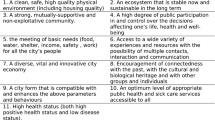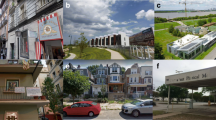Abstract
This paper demonstrates a spatial approach towards the definition of localities for health care planning. Recent international decentralisation of health care provision, and more specifically devolution within the United Kingdom, emphasises the need to develop a geographical focus in the delimitation of local structures for health care planning. Geographers, but most especially those applying Geographical Information Science (GIS) techniques, have made enormous contributions in this field and more generally in research related to health services. This paper considers some of these previous approaches and moves on in the light of new technologies, and more importantly the availability of appropriate data, to create localities that reflect dynamic spaces of social interaction, administration and policy. The paper’s focus is placed on the importance of flow data that reflects␣the spatial interaction between services and the population. This data, divided into three sub-groups of administration, education and health, allows us to identify the population’s allegiance to place and ultimately create spatially bounded functional localities that reflect this. Whilst the approach is largely technology driven, it also incorporates the expertise of local health care professionals thus recognising the importance of collaboration and multi-sectoral engagement. Although this combined approach impacted upon the way in which the final localities were defined, crucially it enabled us to incorporate features of both rigorous spatial analysis and a wealth of local knowledge.
Similar content being viewed by others
References
Balogh, R. (1996). Exploring the role of localities in Health commissioning: A review of the literature. Social Policy and Administration, 30, 99–113
Bradford, M. (1991). School-performance indicators, the local residential environment, and parental choice. Environment and Planning A, 23, 319–332
Brown, L. A., & Holmes, J. (1971). The delimitation of functional regions, nodal regions and hierarchies by functional distance approaches. Journal of Regional Science, 11, 57–72
Bullen, N., Moon, G. & Jones, K. (1993). The definition of geographical communities for health planning: Final report. Chichester, Health Information Research Service, University of Portsmouth.
Butler, T., & Roland, M. (1998). How will primary care groups work? British Medical Journal, 316, 214–214
Campari, I. (1996). Uncertain boundaries in urban space. In P. A. Burrough, & A. U. Frank (Eds.), Geographic objects with indeterminate boundaries (pp. 57–70). London: Taylor and Francis
Chisholm, J. (1998). Primary care and the NHS white papers. British Medical Journal, 316, 1687–1688
Clark, G. L. (1982). Instrumental reason and policy analysis. In D. T. Herbert, & R. J. Johnston (Eds.), Geography and the urban environment (pp. 41–61). London: John Wiley & Sons, Ltd.
Clarke, G. P., & Langley, R. (1996). A review of the potential of GIS and spatial modelling for planning in the new education market. Environment and Planning C, 14, 301–323
Commission on Medicare. (2001). Caring for medicare: Sustaining a quality system. Canada: Saskatchewan
Cooke, P. (1986). The changing urban and regional system in the United-Kingdom. Regional Studies, 20, 243–251
Coombes, M. (2000). Defining locality boundaries with synthetic data. Environment and Planning A, 32, 1499–1518
Coombes, M., & Openshaw, S. (2001). Contrasting approaches to identifying ‘Localities’ for research and public administration. In A. Frank, J. Faper, & J. P. Cheylan (Eds.), Life and motion of socio-economic units (pp. 301–315). London: Taylor & Francis
Court, M. & Phillips, D. R. (1985). Grassrooting. The Health Services 29th October
Craig, N., McGregor, S., Drummond, N., Fischbacher, M., & Iliffe, S. (2002). Factors affecting the shift towards a ‘primary care-led’ NHS: A qualitative study. British Journal of General Practice, 52, 895–900
Day, T. (1990). Getting closer to the consumer? Locality planning in the Exeter health district. Bristol: University of Bristol
Department of Health. (1997). The new NHS: Modern, dependable. London: HMSO
Department of Health. (2006). Our health, our care, our say: A new direction for community services White Paper. London: HMSO
Duncan S., & Savage M. (1991). New perspectives on the locality debate. Environment and Planning A, 23, 155–164
Dunford H., & Hughes J. (1988). Pimlico Patch Committee: An experiment in locality planning. London: Primary Health Care Group, King’s Fund Centre
Erickson, G. M., & Finkler, S. A. (1985). Determinants of market share for a hospital’s services. Medical Care, 23, 1003–1018
Ferguson, S., & Irvine, B. (2003). Hungary’s health care system. London: Civitas-The Institute for the Study of Civil Society
Fincher, R. (1989). The social-relations of localities-spatial divisions of labor and the local state. Environment and Planning A, 21, 674–677
Gibson, A. J., & Asthana S. (2000). Estimating the socioeconomic characteristics of school populations with the aid of pupil postcodes and small area census data: An appraisal. Environment and Planning A, 32, 1267–1285
Government of Ireland (2001). Primary care a new direction: Quality and fairness a health system for you. The Stationery Office, Dublin
Griffith, J. R., Restuccia, J. D., Tedeschi, P. J., Wilson, P. A., & Zuckerman, H. S. (1981). Measuring community hospital services in Michigan. Health Services Research, 16, 135–160
Hillery, G. A. (1995). Definitions of community: Areas of agreement. Rural Sociology, 20, 111–124
Iliffe, S., & Munro, J. (2000). New labour and Britain’s National Health Service: An overview of current reforms. International Journal of Health Services, 30, 309–334
Kearns, R. A., & Joseph, A. (1993). Space in its place: Developing the link in medical geography. Social Science & Medicine, 37, 711–717
King, M., & Court, M. (1984). A sense of scale. Health and Social Service Journal, 21, 734–735 June
Kivell, P. T., Turton, B. J., & Dawson, B. R. P. (1990). Neighbourhoods for health service administration. Social Science and Medicine, 30, 701–711
Kvamme, O., Olesen, F., & Samuelsson, M. (2001). Improving the interface between primary and secondary care: A statement from the European Working Party on Quality in Family Practice (EQuiP). Quality Health Care, 10, 33–39
Mitchell, B. (1988). A guide to Irish parish registers. Baltimore: Genealogical Publishing Co
Naish, J., Macarlean, D., Sharples, P., Curtis, S., Gilham, V., Gregory, I., Ball, C., & Eldridge, S. (1998). Partners in information management: multi sectoral information in a primary care group area. London: Queen Mary and Westfield, East London & City Health Authority & The Wolfson Institute for Preventative Medicine
New Zealand Ministry of Health (2001). The primary health care strategy. Wellington
Norheim, L. (1999). Community development for health—A Resource Guide for Health Workers. Lancaster: Lancaster University Public Health and Health Professional Development Unit
Odoi, A., Wray, R., Emo, M., Birch, S., Hutchison, B., Eyles, J. & Abernathy, T. (2005). Inequalities in neighbourhood socioeconomic characteristics: potential evidence-base for neighbourhood health planning. International Journal of Health Geographics 4
Openshaw S., & Alvanides S. (2001). Designing zoning systems for the representation of socio-economic data. In A. Frank, J. Raper & J. P. Cheylan (Eds.), Life and motion of socio-economic units. London: Taylor & Francis
Shortt, N. K. (2002). Defining regions for locality health care planning: A multidimensional approach. Unpublished Ph.D. Thesis. School of Biological and Environmental Studies. Coleraine, University of Ulster
Shortt, N. K., Moore, A. J., Coombes, M., & Wymer, C. (2005). Defining regions for locality health care planning: A multidimensional approach. Social Science & Medicine, 60, 2715–2727
Taket, A. R., & Curtis, S. E. (1989). Locality planning for health care: A case study in East London. Area, 21(4):357–364
Victorian Government. (2001). Primary care strategy-primary care partnerships. Victoria: Australia Department of Human Services
WHSSB. (1998). Summary of responses to fit for the future. Derry: Western Health and Social Services Board (WHSSB)
World Health Organisation (1991). Sundsvall statement on supportive environments for health. 3rd International Conference on Health Promotion, Sundsvall, Sweden
Acknowledgements
The authors are extremely grateful to Professor Mike Coombes of CURDS at the University of Newcastle upon Tyne and Colin Wymer who both assisted with the ERA analysis.
Author information
Authors and Affiliations
Corresponding author
Rights and permissions
About this article
Cite this article
Shortt, N.K., Moore, A.J. “Functional localities: an integrated spatial approach towards health care locality definition”. GeoJournal 67, 27–40 (2006). https://doi.org/10.1007/s10708-006-9005-4
Received:
Accepted:
Published:
Issue Date:
DOI: https://doi.org/10.1007/s10708-006-9005-4




